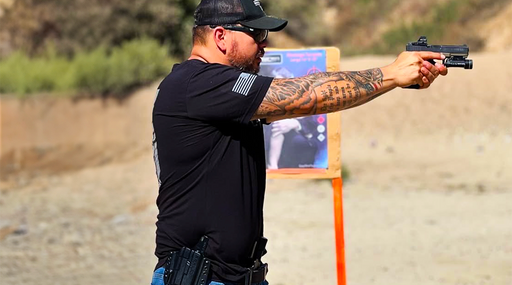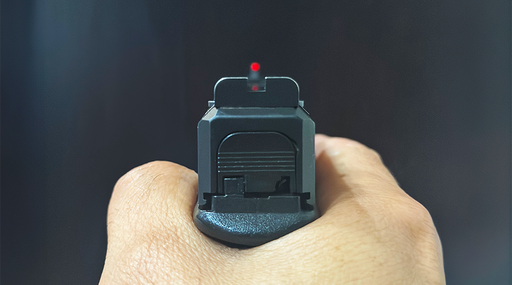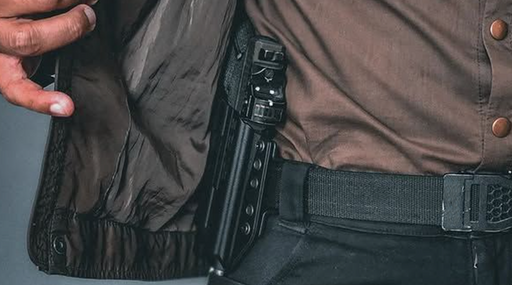Stance is the relationship of your center of gravity, AKA body mass, to recoil. While most people think of stance in terms of the standing position, really there is a nearly endless variety of stances: standing, kneeling, sitting, prone, supine, and variations on those themes. Indeed. there exists a wonderful variety of stances. But here we’ll focus on the standing position, as that’s where most people start their shooting experience. Knowing the basics of your chosen art, pastime, or defensive pursuit is kind of important! Aside from scholarly reasons, a good stance allows your own mass to counter the gun’s recoil as effectively as possible. Stance, along with grip and follow-through, are three fundamentals essential for firing multiple rounds as quickly as possible.
Without a good stance, accuracy and even health can suffer. When standing in a weak stance, rounds tend to “climb” the target, and misses go high as the shooter’s body is ratcheted rearward with each successive shot. This backwards-ratcheting action may not cause injury to the spine, but it can aggravate any nagging lower back issues as the upper back is pushed unnaturally rearward.
The ol’ Weaver versus Isosceles debate
I am focused on the so-called isosceles stance here, which means the shooter stands squarely facing the target, with or without the strong side foot placed a few inches rearward. Looking at the shooter from behind, their legs form an isosceles triangle from the ground. Looking at them from directly above, their chest and outstretched arms form another.
The Weaver stance, in which the shooter’s strong side is angled away from the target, works just fine. It has faded from popularity in law enforcement training as studies have found it can be more time-consuming to use. Both stance types work just fine. Interested readers can find the comparison studies. A true tactician will employ the Weaver position at least some of the time as they navigate narrow openings. For purposes of simplicity and in keeping with the state of the art, this article’s focus is on isosceles. Arguments about which one is best miss the important point that any good stance minimizes the effects of recoil. In this regard both stance types can work, and both can fail depending on how they’re used.
How-To
An effective isosceles stance starts with feet shoulder width or even a little more apart. If you want to place one foot a little back, try and make it your strong (trigger finger) side foot, and step back only enough to put its big toe in line with the arch of your other foot. Knees are soft, not bent and not locked. Extend both arms toward the target, “locking out” the firing hand arm while maintaining a tight grip and maybe even rearward pressure with the support arm. The gun should be raised so the sights are at your eye level.
Now, bend the upper body forward at the hip. Look down to check and see if your shoulders are right above your toes. Feel that your weight is in the balls of your feet.
Doing the above will make a virtual shock absorber out of your body. It will react less dramatically to recoil and your shots won’t climb higher as you go, assuming your grip (another fundamental for another day) is good and solid. Grip and stance go together in a fashion similar to the relationship of your hands on the steering wheel to your car’s tires.
- • This is stupid or weird. This is most often the mindset encountered by straight-standers who have spent a lot of time shooting in casual settings but have never had formal training. Sometimes, it crops up with women who feel like they’re sticking their butt out to shoot. Once they both discover that they can shoot faster and have greater control over the gun by leaning forward from the hip rather than standing straight up, it’s easier for them to give up a habit that was holding them back. Also, it turns out nobody at the range cares if you feel like your butt’s sticking out!
- •This feels too aggressive. This is usually an unspoken attitude that people who feel unsure of themselves with a firearm, and sometimes in general, suffer from. Indeed, some people have experienced social punishment for having an assertive or aggressive approach. The resultant emotional scars can be expressed in a defeated posture that interferes with good gun handing. A forward stance does create a commanding non-verbal presence when done correctly. Shooters who feel uncomfortable asserting themselves socially can feel like a fish out of water using a functional stance. The rewards of successful shooting with a good stance, in a supportive environment, usually erase those feelings quickly. It can also build the self-confidence that is, in itself, preventive medicine against predation by criminal actors.
Lay the foundation right
Stance is the first fundamental applied before firing one or more shots. By following the simple guidelines described here, and eliminating the common mistakes from your stance, the foundation is laid for excellent shooting. Not to mention, you’ll look like a pro doing it. Have fun!
Eve Flanigan is a defensive shooting and concealed carry instructor living in the American Southwest. Today she works full time as an instructor and writer in the gun industry. Flanigan loves helping new and old shooters alike to develop the skills needed to keep themselves and their loved ones safe.





















Leave a comment
1 comment
Eve, my husband and I want to renew our CCW. Please contact us at 575-885-3836 or 505-249-1523. Judy and Norbert Rempe. Thanks